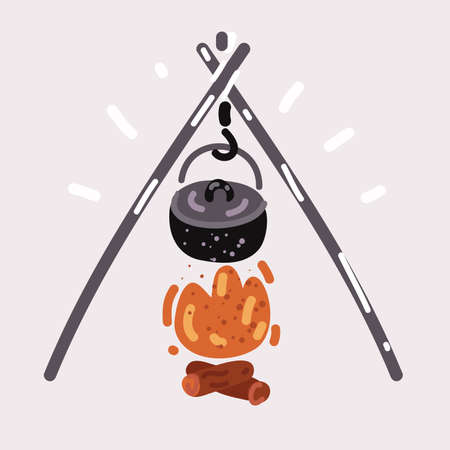1. The Charm of Campfire Cooking
There’s something undeniably magical about cooking over an open fire. Whether it’s the crackling wood, the scent of smoke drifting through the trees, or the warmth that draws everyone closer, campfire cooking takes us back to a simpler time. It’s nostalgic, grounding, and deeply satisfying—especially when youre miles away from modern conveniences.
One-pot stews are the perfect answer to chilly nights under the stars. After a long day of hiking, fishing, or just relaxing at your campsite, theres nothing more comforting than gathering around a fire with a hearty meal simmering in one pot. These stews bring together everything we love about camping: simplicity, flavor, and a sense of community.
Not only do one-pot meals cut down on cleanup—something every camper can appreciate—but they also allow you to cook delicious, filling dinners with minimal fuss. You don’t need a full kitchen setup; just a sturdy pot, a good heat source, and some basic ingredients.
Why One-Pot Stews Are Perfect for Campfire Cooking
| Benefit | Description |
|---|---|
| Simple Prep | All ingredients go into one pot—less chopping, fewer dishes. |
| Easy Cleanup | Fewer utensils and cookware mean less to wash after eating. |
| Hearty & Filling | Stews are packed with protein, veggies, and carbs for energy. |
| Great for Sharing | Perfect for feeding small groups around the campfire. |
The best part? You don’t have to be an expert chef to pull this off. Even beginners can create flavorful meals using simple techniques passed down through generations of outdoor lovers. Just toss your ingredients in the pot, let them simmer over glowing coals, and enjoy the rich flavors that only come from slow cooking in natures kitchen.
2. Essential Gear for One-Pot Stews
When it comes to making hearty one-pot stews over a campfire, having the right gear can make all the difference. Whether youre camping in the mountains or enjoying a chilly night at a state park, these tools will help you cook up warm, comforting meals with ease.
Must-Have Campfire Cooking Tools
Before you head out, make sure your camp kitchen is stocked with these essentials:
| Gear | Description | Why It’s Important |
|---|---|---|
| Cast Iron Dutch Oven | A heavy-duty pot with a tight-fitting lid, ideal for slow cooking over open flames. | Even heat distribution and durability make it perfect for stews. |
| Tripod or Grill Grate | A metal stand or grate placed over the fire to hold your Dutch oven securely. | Keeps your pot stable and allows better heat control. |
| Long-Handled Utensils | Spoons, ladles, and tongs made of stainless steel or heat-resistant materials. | Protects your hands from the heat while stirring or serving. |
| Heat-Resistant Gloves | Thick gloves designed to handle hot cookware safely. | Essential for lifting lids and moving pots around the fire. |
| Lid Lifter or Hook | A tool specifically designed to lift hot Dutch oven lids. | Makes it easy and safe to check on your stew without burns. |
Tips for Prepping Your Gear for Outdoor Use
Season Your Dutch Oven
If your Dutch oven is made of raw cast iron (not enamel-coated), be sure to season it before use. Rub a thin layer of vegetable oil on the inside, then bake it in an oven at home (or over low coals) until its dark and non-stick. This prevents rust and improves cooking performance.
Packing Smart
Use plastic bins or canvas totes to organize your campfire cooking gear. Keep items like utensils, gloves, and lid lifters together so they’re easy to grab when the fire’s going. Store your Dutch oven separately in a padded case or wrap it in towels to protect other gear from its weight and edges.
Clean-Up Essentials
Bring along biodegradable soap, scrub brushes, and extra water for cleaning up after dinner. A small folding table can also help keep things off the ground while you prep and clean. Don’t forget trash bags — pack out everything you pack in!
Pro Tip:
If youre camping somewhere with unpredictable weather, pack a backup fuel source like a propane stove. That way, you can still cook your stew even if the firewood is wet or conditions aren’t safe for an open flame.
Having the right tools makes cooking one-pot stews over a campfire not just possible but enjoyable. With just a few key pieces of gear and some smart prep, youll be ready to serve up warm bowls of comfort under the stars.

3. Base Ingredients for Hearty Stews
When youre out in the wild, cooking over a campfire should be simple, satisfying, and full of flavor. That’s why one-pot stews are a go-to meal for campers who want something warm and hearty after a long day outdoors. The secret? Packing your cooler with ingredients that are not only flavorful but also durable enough to handle rustic conditions.
Root Vegetables: Nature’s Powerhouses
Root vegetables are perfect for campfire stews. They’re packed with nutrients, hold up well without refrigeration for a few days, and bring natural sweetness and depth to your dish. Think carrots, potatoes, sweet potatoes, parsnips, and turnips.
Popular Root Veggies for Stews
| Vegetable | Flavor Profile | Storage Tips |
|---|---|---|
| Carrots | Slightly sweet, earthy | Keep in a cool, dry place or wrapped in a damp towel in your cooler |
| Potatoes | Starchy, mild | Store in a breathable bag away from direct sunlight |
| Sweet Potatoes | Savory-sweet, hearty texture | No need to refrigerate; keep dry and cool |
Proteins: The Heart of the Stew
You’ll need a good protein source to make your stew filling and flavorful. Choose options that travel well and cook evenly over a fire. Canned beans are a great vegetarian choice, while diced beef chuck, ground turkey, or smoked sausage can bring big flavor with minimal effort.
Camp-Friendly Protein Options
| Protein | Why It Works | Packing Tips |
|---|---|---|
| Canned Beans (Black, Kidney, Pinto) | No refrigeration needed, high in fiber and protein | Bring pop-top cans or pack a manual can opener |
| Diced Beef Chuck or Stew Meat | Tenderizes beautifully when slow-cooked over fire | Pre-freeze at home and keep on ice in the cooler |
| Smoked Sausage or Kielbasa | Adds smoky depth with no extra seasoning needed | Vacuum-sealed packs stay fresh longer in the cooler |
Herbs & Broths: Boost the Flavor Naturally
Aromatic herbs like rosemary, thyme, bay leaves, and garlic add serious depth to your stew without needing fancy sauces. As for broth, opt for shelf-stable cartons or bouillon cubes—theyre lightweight and easy to pack.
Flavor Enhancers Worth Bringing Along
- Dried Herbs: Lightweight and long-lasting—perfect for multiple meals.
- Fresh Garlic & Onions: Sturdy enough for camping and bring bold flavor.
- Bouillon Cubes: Compact and customizable—just add water.
- Shelf-Stable Broth Cartons: Great if you have space in your cooler.
Pro Tip:
Mix your dried herbs into a small spice jar before your trip so you can season on the fly without digging through bags.
A well-stocked cooler filled with these base ingredients will set you up for success around the campfire. With just one pot and some heat, youll be dishing out hearty meals thatll warm everyone under the stars.
4. Classic and Creative Campfire Stew Recipes
There’s nothing like a hearty, one-pot stew to warm you up after a long day of outdoor adventure. Whether youre camping in the mountains or enjoying a chilly night under the stars, these campfire stews are easy to make, packed with flavor, and perfect for sharing. From classic comfort food to bold new twists, here are some must-try recipes for your next trip.
Cowboy Chili
This hearty stew is a favorite around the campfire. Loaded with ground beef, beans, tomatoes, and spices, cowboy chili is filling, flavorful, and easy to cook over open flames.
Ingredients:
- 1 lb ground beef
- 1 can kidney beans (drained)
- 1 can diced tomatoes
- 1 small onion (chopped)
- 1 tbsp chili powder
- Salt and pepper to taste
Instructions:
- Brown the ground beef in your Dutch oven over the fire.
- Add onions and cook until soft.
- Stir in beans, tomatoes, and seasonings.
- Simmer for 20–30 minutes until thickened.
Veggie-Loaded Campfire Gumbo
If youre looking for something colorful and plant-powered, this veggie gumbo is your go-to. Its smoky, savory, and packed with good-for-you ingredients.
Main Ingredients:
| Vegetable | Amount |
|---|---|
| Bell peppers (mixed colors) | 2 cups chopped |
| Zucchini | 1 cup sliced |
| Okra (optional) | 1 cup chopped |
| Diced tomatoes | 1 can |
| Vegetable broth | 2 cups |
Cooking Steps:
- Sauté vegetables in oil over medium heat until softened.
- Add diced tomatoes and broth.
- Season with Cajun seasoning or smoked paprika.
- Let simmer for about 30 minutes for full flavor.
Smoky Sausage & Potato Stew
This stew brings together smoky sausage and tender potatoes in a rich broth. It’s rustic, satisfying, and made for cool nights by the fire.
You’ll Need:
- 1 lb smoked sausage (sliced)
- 3 medium potatoes (diced)
- 1 onion (chopped)
- 2 cloves garlic (minced)
- 3 cups chicken broth
- A pinch of thyme or rosemary
How to Make It:
- Sauté sausage slices until browned.
- Add onions and garlic; cook until fragrant.
- Toss in potatoes and pour in chicken broth.
- Add herbs and let simmer until potatoes are tender—about 25 minutes.
Create Your Own Campfire Stew Mix
If youre feeling creative, mix and match ingredients based on what you have on hand. Here’s a simple guide to build your own custom one-pot stew at camp:
| Category | Options |
|---|---|
| Protein | Ground beef, sausage, chicken thighs, tofu, lentils |
| Main Veggies | Potaotes, carrots, bell peppers, zucchini, corn |
| Liquid Base | Chicken broth, vegetable broth, tomato sauce, coconut milk |
| Flavor Boosters | Garlic, onion powder, chili flakes, herbs (thyme/rosemary), bay leaves |
| Add-ons (Optional) | Canned beans, rice, pasta shells, leafy greens (spinach/kale) |
No matter which stew you choose to make at camp—classic or creative—you’re guaranteed a warm bowl of comfort that brings everyone together around the fire.
5. Fire Management and Cooking Techniques
When youre cooking one-pot stews over a campfire on a chilly night, managing your fire properly can make all the difference between a perfectly simmered meal and a burnt mess. Here’s how to build and control your fire so that your stew turns out warm, hearty, and full of flavor every time.
Building the Right Fire
Start with the right setup. A good cooking fire isn’t just about big flames—it’s about creating steady, manageable heat. Use the “log cabin” or “teepee” method to get things started, then let it burn down to glowing embers before you begin cooking. Embers provide even heat and are ideal for simmering stews in a Dutch oven or heavy-bottomed pot.
Common Campfire Building Styles
| Style | Description | Best Use |
|---|---|---|
| Teepee | Sticks arranged in a cone shape for quick ignition | Starting your fire quickly |
| Log Cabin | Larger logs stacked like Lincoln Logs with kindling inside | Longer-lasting and stable base for cooking |
| Pyramid | Larger logs on the bottom, smaller ones on top | Cooks down into hot coals efficiently |
Controlling Heat Zones
A key trick is setting up different heat zones. Push some coals to one side for high heat, and leave another area with fewer coals for low heat. This gives you more control when cooking ingredients that need to simmer slowly or be brought to a boil first.
Heat Zone Setup Tips
- High Heat Zone: Directly over fresh coals; great for browning meat before adding liquids.
- Medium Heat Zone: Slightly away from the hottest part; ideal for maintaining a gentle simmer.
- Low Heat/Keep Warm Zone: Edge of the fire ring or fewer coals underneath; perfect for letting flavors meld while you prep other things.
Timing Your Stew Right
The weather, wind, and even the type of wood can affect your cooking time. Start checking your stew after about 30–45 minutes of simmering. Stir often to prevent sticking and make sure everything cooks evenly. Add water or broth as needed if too much liquid evaporates due to high heat or dry conditions.
Campsite Cooking Pro Tip:
If youre using a cast-iron Dutch oven, rotate the pot every 15 minutes (and the lid in the opposite direction) for even cooking without hot spots.
A well-managed fire is the heart of every successful campfire stew. With a little practice, youll be able to read your flames and coals just like youd read a stove dial at home—except now you’re doing it under the stars.
6. Cleanup and Storing Leftovers in the Wild
After a hearty bowl of one-pot campfire stew, its tempting to kick back and relax. But part of being a responsible camper—especially in bear country—is making sure your cooking area is cleaned up properly and any leftovers are stored safely. Heres how to do it the eco-friendly, leave-no-trace way.
Eco-Friendly Cleanup
Cleaning up after your camp meal doesnt have to be a hassle. These steps keep your campsite clean and nature unharmed:
- Use biodegradable soap: Always choose a biodegradable soap specifically made for camping.
- Strain your dishwater: Use a mesh strainer to catch food particles before you dispose of water.
- Dispose water properly: Scatter strained dishwater at least 200 feet away from streams or lakes.
- Pack out scraps: Never bury food waste. Pack out all leftovers and food particles in a sealed trash bag.
Waste Management: Leave No Trace Principles
The Leave No Trace ethic is all about minimizing our impact on nature. When it comes to campfire stews and other meals, heres what you should remember:
| Do | Dont |
|---|---|
| Pack out all food waste and packaging | Bury or burn food scraps |
| Use reusable containers and utensils | Rely on disposable plates or plasticware |
| Clean dishes at least 200 ft from water sources | Wash dishes directly in streams or lakes |
Storing Leftovers Safely in Bear Country
If youre camping in areas known for wildlife—especially bears—youll need to store any leftover stew with caution. Bears have an incredible sense of smell, so even small traces of food can attract them.
Bear-Safe Storage Tips:
- Use bear-proof containers: Certified bear-resistant canisters are the safest option.
- Hang food bags properly: If canisters arent available, hang food bags at least 10 feet off the ground and 4 feet away from tree trunks.
- No food in tents: Never store leftovers inside your tent or sleeping area—even sealed containers can attract animals.
Pro Tip:
If youre staying at a developed campground, use provided bear lockers for all scented items including leftovers, cooking gear, and trash. In backcountry areas, follow local guidelines for food storage—they vary by region but always aim to protect both people and wildlife.
A little extra effort goes a long way toward keeping your campsite safe and pristine—for you, future campers, and the wild animals that call it home.

